Designers do not work in a vacuum, they work with other designers, directors, managers, actors, crafts people, dramaturges, and producers. Discretion is something to be learned early and practiced every day. This is a small business. Collaborations, in different configurations, can last a lifetime.
The work of entertainment is a social business. Meetings happen in restaurants and coffee shops, more often than they happen in meeting or conference rooms. Small talk and polite sharing of interests is as important as the work. It’s often camaraderie that helps to define long-term working relationships.
Working as an assistant is often the introduction to the process. In this role, discretion is especially important. Questions for the boss might be best held until a private dinner. Those dinners, and remembering how the boss takes their coffee, are often as important as design skills in developing a long term relationship. Being an assistant is something like being an actor. Assistants have to learn the role of designer, as well as the tastes and preferences of the specific designer they are assisting.
In general, the work of interpretation and planning takes place during pre-production. That is one school of thought, and generally the predominate approach.
Whatever the process, the production team needs to arrive jointly at a concept. They need to determine the dramatic question, and set about to answering that question.
Discretion will always be the better part of valor.
From a producer’s point of view, a business point of view, keeping the experimentation, examination, and thought processes in pre-production helps to control costs.
There are other methods. Here are a couple.
The Open Theatre which existed from the mid-1960s until the mid-1970s was a collaborative group of actors working with directors and writers in an improvisational manner. The group developed the script and eventually added designers to the mix.

Julian Beck and Judith Malina, founders of the Living Theatre, rehearse with an unidentified actor in New York in 1983.
Viewpoints is a means of interpretation that brings the entire cast and crew into the rehearsal space. Viewpoints is a technique that creates a specific vocabulary for a specific production. As the actors develop their characters, they are also encouraged to make suggestions regarding the design choices. Similarly, the designers are welcome to make suggestions to the actors, while possibly introducing props, clothes, instruments, and whatever into the rehearsal process.
There are wonderful, and romantic, if not always accurate, images of artists working in solitude to create great masterpieces. We can all picture a writer, alone in a room piled high with books and letters, tapping away on an old Underwood manual typewriter while overlooking stormy ocean waves crashing onto a rocky shore. The rooftops of Paris at dusk can easily evoke the image of a young, starving painter toiling away while snow falls through a broken skylight into the garret studio.

The Poor Poet, Carl Spitzweg, 1839, oil on canvas.
However, Michelangelo did not paint the Sistine Chapel ceiling alone, He had a slew of assistants and apprentices, much like contemporary theatrical designers. Sure there are times when every designer needs to withdraw to their personal space to think, read, contemplate, or doodle and noodle, but generally we work with others. We collaborate.
We work with each other, we help each other, and we inspire one another. We work as a team, and in turn, each designer has a team, not only of assistants and associates, but also artisans, crafts people, and programmers, all of whom have to interface with stage managers, producers, and production managers. We need to be able to collaborate whether everyone is in the same room, or spread around the world.
We all need to be honest with one another and trust one another. Dishonesty can kill trust, on this production and every production going forward. If you encounter a problem, bring that issue to everyone’s attention as soon as possible. Use discretion, and don’t cry wolf.
Know when, where, and how to communicate.
Each designer needs to be unafraid to present their ideas, ask and answer questions, and defend positions. It is important to be fearless and be supported by colleagues.
The color calculus between the disciplines is critical. To be sure that the stage pictures are what is intended by all, and expected by the director and the producer, the designers need to communicate their ideas and desires.
It isn’t assumed that any one person can possess all of the knowledge and talent that the group can bring to the table. While there are certainly Scenographers that have multiple specialties, it isn’t likely that one individual can master every visual design discipline, and compose incidental music. There are directors who design, but normally they do not design every aspect of a production. Many designers rely on the skills of their assistants. Always hire people who are better at what you need them to do than you are. That does not diminish the designer who will still curate and direct the work of the assistant or staff.
Have your colleague’s back.
We all also need to be able to check the work of our colleagues. That’s not a negative, that is having your partner’s back.
Besides, if you’re the costume designer, you may have an idea about how the show might sound. There’s nothing wrong with that.
When we leave our garrets and sit with the other designers, director, and the members of the team, we need to come to agreement about the overall concept. While everyone’s concept and metaphor do not have to match, they have to be of a family. A production team needs a shared interpretation and a unified concept. In other words, everyone needs to be telling the audience the same story.
That does not mean that everyone comes to the table, or FaceTime, in agreement. Collaboration can mean selling your idea, convincing the others that your idea is a good idea, indeed, the best idea. Collaboration can mean compromise, for you, or another member of the design team. Collaboration may even mean changing your mind. Be open.
Theatre is a group effort; the larger the production, the larger the group. The larger the group, the more challenging the collaboration. That means keeping on top of your communications, and making sure the others do the same.
Collaboration happens on many levels. There are the obvious that have been stated here repeatedly.
Let’s look up and down the ladder a bit. If possible, the playwright might be collaborating with the director, as well as the producer. An enlightened producer and/or director will also connect the playwright with the designers so there is clarity in regard to the playwright’s Point of View.
Each designer has a crew and a means of communicating their design ideas, to the director, to the producers, management, the acting company and to the shops that will be responsible for executing the designs. This communication begins with conversation that includes using visual or auditory ideas to communicate concept and direction. Generally, this conversation is with the other designers and the director.
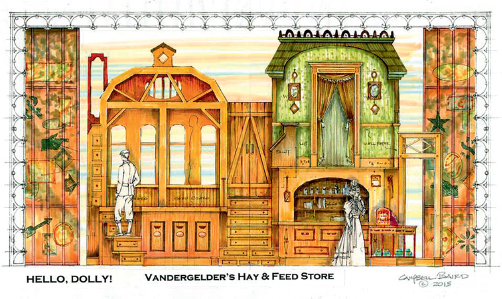
Campbell Baird’s scenic elevations and renderings served several purposes; they communicated his ideas to the director and other designers, they gave the producers an understanding of what they were paying for, and they were used by the crew to execute the work.
Eventually, the producers are brought into the loop. The producers are going to pay for the designs, they will need to be sold on the ideas. The sooner the producers or investors are brought into the process, and introduced to the visual idea, the sooner they can buy-in to that idea, the more likely they will be to reach into their pockets. Do not fail to respect the role of the producers and the investors, and do not fail to show them the proper respect and attention.
Once ideas are chosen and expressed, sketches and doodles need to become renderings. Sometimes that is the work of the individual designer, sometimes there is an assistant, an illustrator, or a sketch or storyboard artist engaged to bring the design ideas to life. Certainly at first, every designer will and should personally create their own presentations.
Fabric needs to be shopped, light plots drawn, designer elevations/working drawings created, cue sheets written, tracks created; the list of documentation and paperwork that make a show is almost endless.

The collaborative group for this corporate experience involved the design team, producers, engineers, an architect, and the scenic studio. Renderings and drawings evolved with everyone’s input until final approval.
Designers need to be able to create these plans, or explain to assistants/associates how to delineate the production. Further, once everything has been planned, the project needs to be executed. That means working with the artisans in the shops and explaining your ideas and intent, so they can properly interpret and execute.
None of this sells any tickets. We all want to sell tickets. That pays our fees. The more successful the producer, the more shows the producer produces and the more opportunities designers have to design. The longer a commercial production runs or tours, the greater the designers’ royalties. So there’s that too.
There is a Gestalt to the Collaboration as well as to the design.

The final product is a match for the renderings. This is what people expect. The medium does not matter, the renderings could be pencil or watercolor, as long as they are accurate.
Producers, directors, and yes, designers collaborate with press agents, publicists, and advertising agencies to promote shows. Ideas for advertising campaigns generally come from the producers and managers, but they often have guidance and assistance from the director, writer and designers. Photo shoots aren’t costumed by the ad agency, the actors wear the costumes designed and created for their characters in the production. Those garments have to be styled for the shoot. Parts of the set, or large format prints based on projections might be used for the background of a photo shoot.
The processes always takes time. Allow everyone the time they need.
Sometimes the design team, director, producers and others are also styled for press and publicity.
Of course the selling of the tickets begins when the production staff is also trying to get the production built, so time must be made for these sales-related interruptions. Just because the costumes are being worn for the photo shoot doesn’t mean they have to be fully completed. The photographer and their camera only sees one side, so the clothes might be taped onto the actor.
Collaboration means that the group is more than the sum of its parts.
ACORD, the Association for Cooperative Operations Research and Development, is a global, non-profit organization serving the insurance industry. ACORD facilitates fast, accurate data exchange, electronic standards, and tools to improve data quality, and increase efficiency. ACORD also presents industry-related video updates, interviews with insurance specialists, and seminars on current technology and business topics.
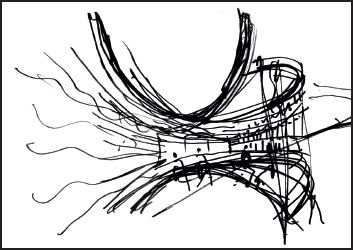
Photography by Raeford Dwyer Artwork by Provost Studio
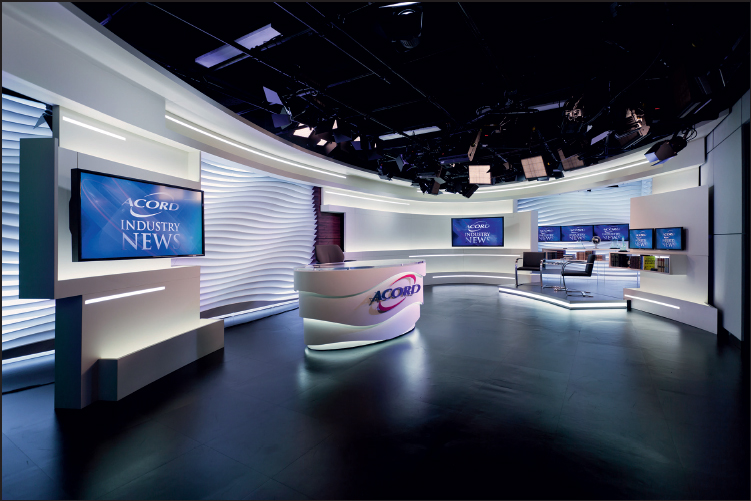

When Peter Provost and Tom Schwinn of Provost Studio approached the challenge of designing a flexible television Studio space for ACORD, there was no script.
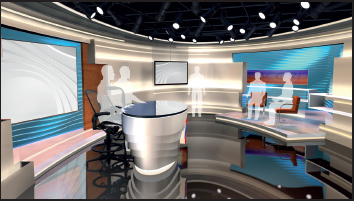
The ACORD Studio provides production space for corporate online web content and special corporate communication initiatives. Technology, including a number of video monitors around the studio, provides the flexibility to re-brand the entire space and/or specific shots for individual broadcasts, programs, events, and/or initiatives.

Andreas Tjeldflaat, 2012 © SRGF

The designers sprung off of the ideas of technology and communications.
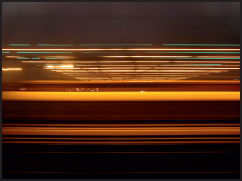
Their research led them to images, textures, and materials which felt like the visualization of these abstract concepts.
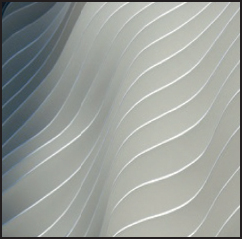

From hand-drawn doodles to clean and accurate computer-generated models and renderings, the designers looked to morph the organization’s two-dimensional logo into three-dimensional space.

